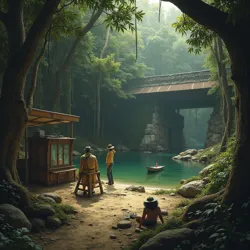Hartmann-Veracruz Expedition
 The primary research camp of the Hartmann-Veracruz Expedition, established near the entrance to Cenote Negro in 1932
The primary research camp of the Hartmann-Veracruz Expedition, established near the entrance to Cenote Negro in 1932The Hartmann-Veracruz Expedition of 1932 was a groundbreaking scientific venture into the Black Cenote District that marked the first systematic attempt to study the region's temporal anomalies. Led by German physicist Dr. Klaus Hartmann and Mexican archaeologist Dr. Isabella Veracruz, the expedition established many of the foundational protocols for researching anomalous zones and documented the first scientific evidence of temporal displacement in the Yucatan region.
Origins and Planning
The expedition originated from Dr. Hartmann's theoretical work on gravitational anomalies and their potential relationship to time dilation. After encountering Dr. Veracruz's archaeological papers describing unusual preservation patterns in artifacts recovered from the Yucatan hinterlands, the two researchers formulated a hypothesis about potential temporal distortions in the region. Their collaboration led to the formation of the Anomalous Physics Research Group at the University of Mexico City, which secured funding for the expedition through a combination of academic grants and private donations.
Initial planning for the expedition took over eighteen months, during which the team developed specialized equipment for measuring temporal variations and establishing baseline chronometric readings. Dr. Veracruz's expertise in Maqamiztleca culture proved crucial, as she incorporated indigenous knowledge about safe navigation of the cenotes into the expedition's protocols. The team also consulted with local guides familiar with the region's peculiarities, though many refused to participate directly in the expedition itself.
The Expedition
 Custom-built chronometric equipment used by the expedition to measure temporal distortions
Custom-built chronometric equipment used by the expedition to measure temporal distortionsThe expedition proper began in March 1932 with a team of twenty-three researchers, including physicists, geologists, archaeologists, and support staff. They established their primary base camp near the entrance to Cenote Negro, constructing a series of reinforced observation posts and instrument stations. The expedition's first major discovery came within days of arrival, when they documented the phenomenon of "lithic flux" - the apparent liquefaction of solid limestone under certain conditions.
Over the following months, the team conducted a series of increasingly sophisticated experiments to measure and document the temporal anomalies. They developed the first systematic mapping of what they termed "temporal gradients" - areas where time appeared to flow at different rates relative to the surrounding space. These measurements led to the development of the Hartmann-Veracruz Scale for quantifying temporal displacement, which remains in use by modern researchers.
The expedition also made significant archaeological discoveries, including several previously unknown Maqamiztlec ritual sites and the first documented examples of "time-worn" artifacts - objects that appeared to age or de-age rapidly when moved between different areas of the district. The team's careful documentation of these phenomena established many of the basic principles later codified in the Chronometric Analysis Protocols.
Challenges and Setbacks
The expedition faced numerous challenges beyond the obvious dangers of the temporal anomalies. Equipment frequently malfunctioned in unpredictable ways, with chronometers showing impossible readings and recording devices capturing events that hadn't yet occurred. Several team members developed severe cases of Cenote Time Sickness, requiring emergency evacuation and leading to the establishment of strict exposure limits for research personnel.
The most significant incident occurred in June 1932, when a four-person research team led by Dr. Hartmann's assistant, Heinrich Weber, ventured into one of the deeper cenotes. Only three members returned, with Weber himself having apparently vanished despite being physically tethered to his colleagues. This event led to the development of the "buddy system" protocols still used in anomalous zone research today.
Scientific Impact
The expedition's findings revolutionized the understanding of temporal anomalies and their relationship to geological formations. Their research provided the first empirical evidence of localized time dilation effects outside of theoretical physics, leading to the development of the Dimensional Convergence Theory. The detailed mapping of temporal gradients within the Black Cenote District established a foundation for all subsequent research in the region.
The team's methodology, particularly their integration of indigenous knowledge with modern scientific techniques, set important precedents for anomalous zone research. Their work directly influenced the establishment of the Temporal Research Station Alpha and the development of modern safety protocols for researchers working in temporally unstable environments.
Legacy and Influence
The expedition's comprehensive documentation and methodical approach established standards that continue to influence anomalous zone research. Their original field notes and measurements remain valuable resources, particularly their observations of long-term temporal cycles within the district. The Hartmann-Veracruz Collection at the University of Mexico City contains thousands of pages of documentation, photographs, and artifacts from the expedition, though some materials remain classified due to their sensitive nature.
The expedition's work also contributed significantly to the understanding of pre-Columbian use of the cenotes. Their archaeological findings provided the first evidence that ancient peoples had developed sophisticated methods for navigating and utilizing the temporal anomalies, leading to renewed interest in traditional knowledge about the region.
See also
- Chronometric Phenomena of the Yucatan
- Early Anomalous Zone Research
- Temporal Measurement Methodologies
References
The primary sources for information about the Hartmann-Veracruz Expedition come from the expedition's official reports, field journals, and subsequent publications by team members. Additional context is provided by the University of Mexico City's archived materials and the oral histories collected from local communities by Dr. Veracruz in the years following the expedition.